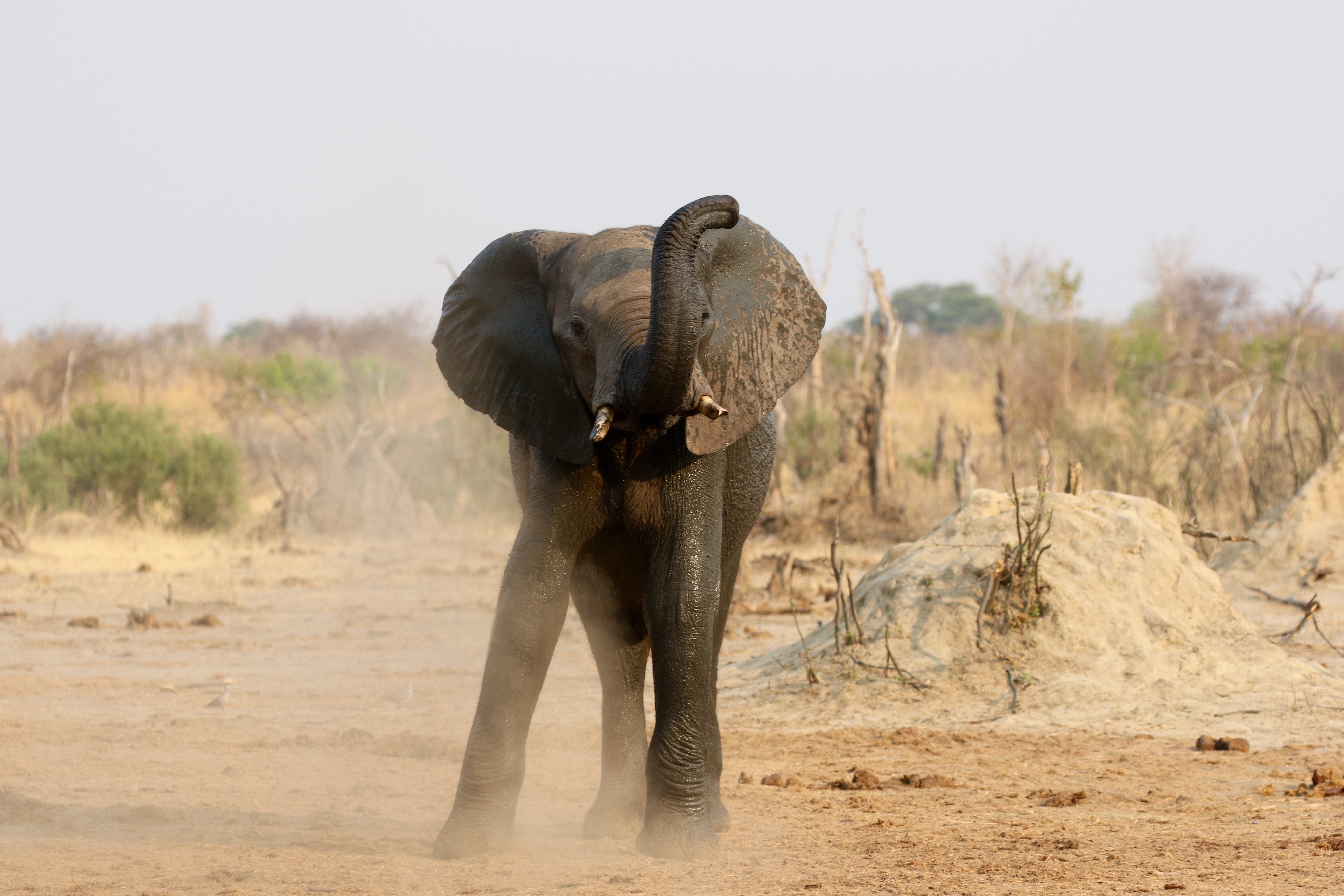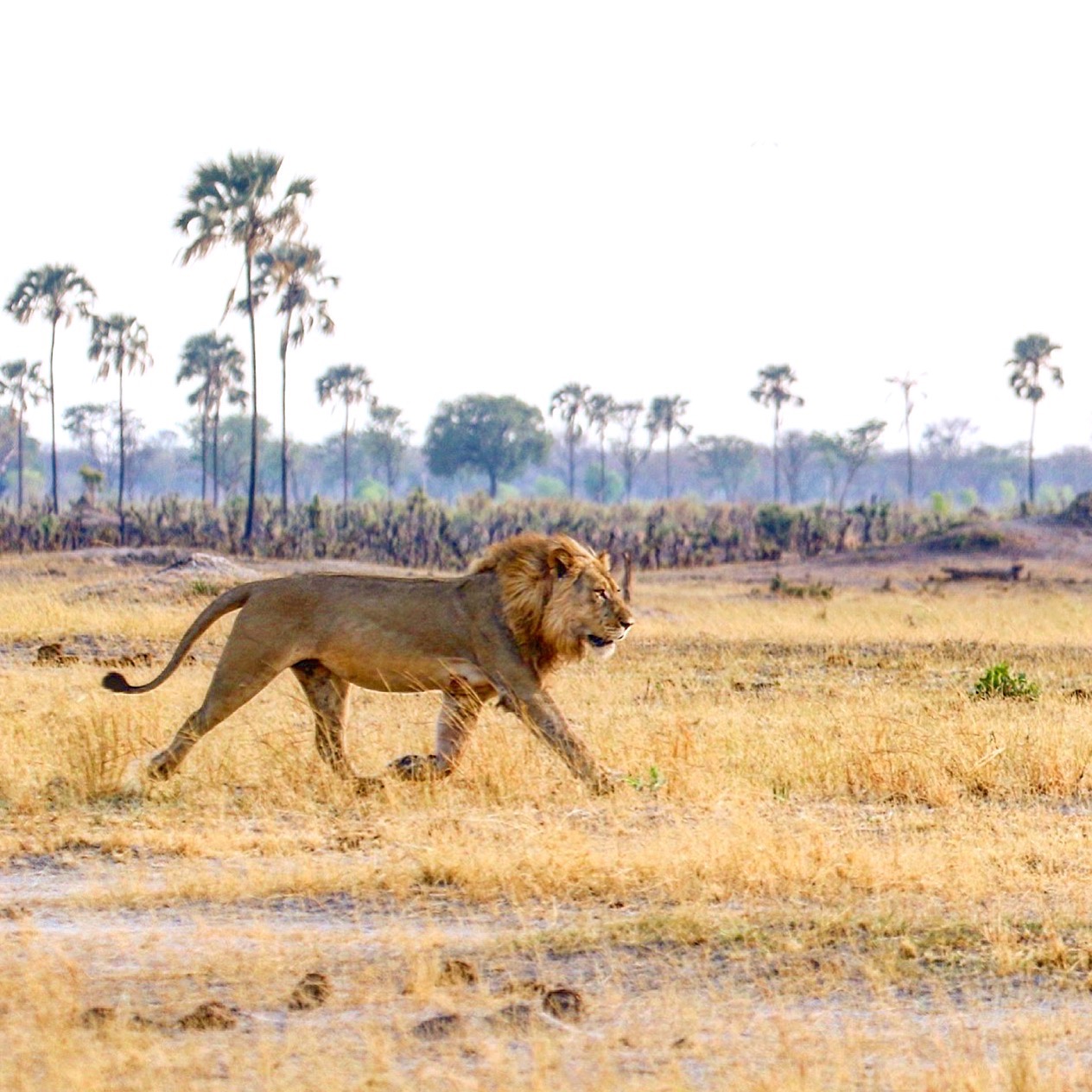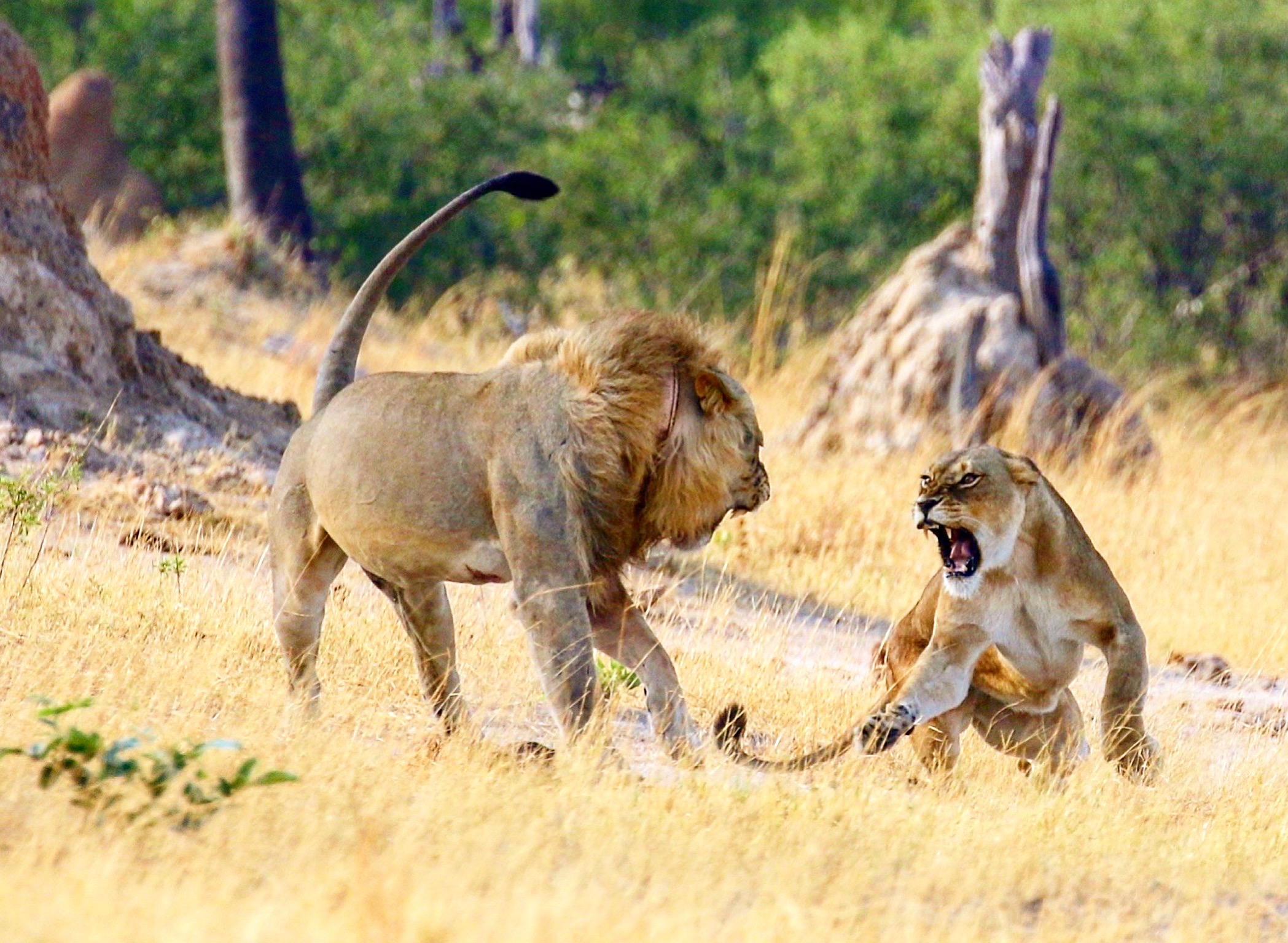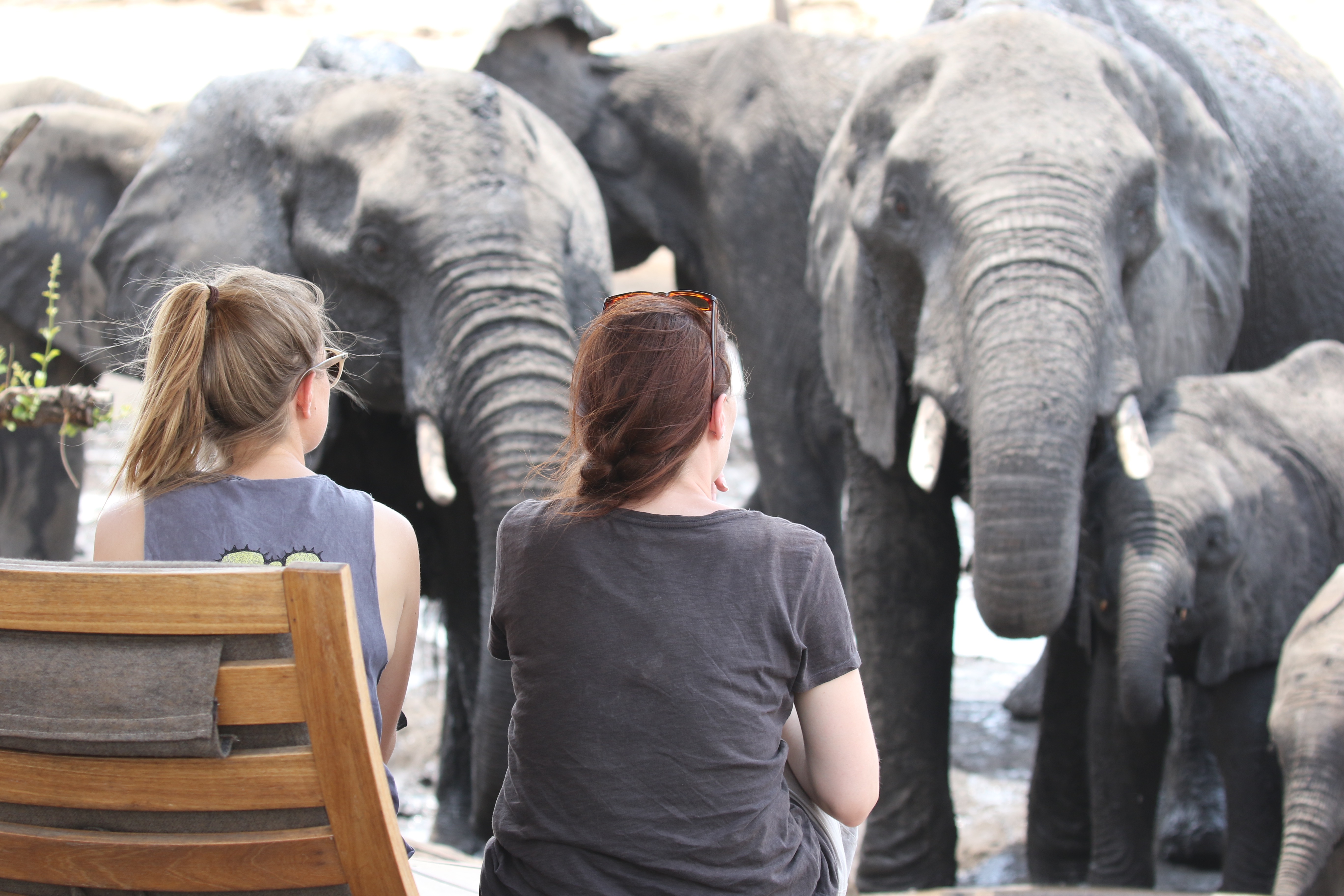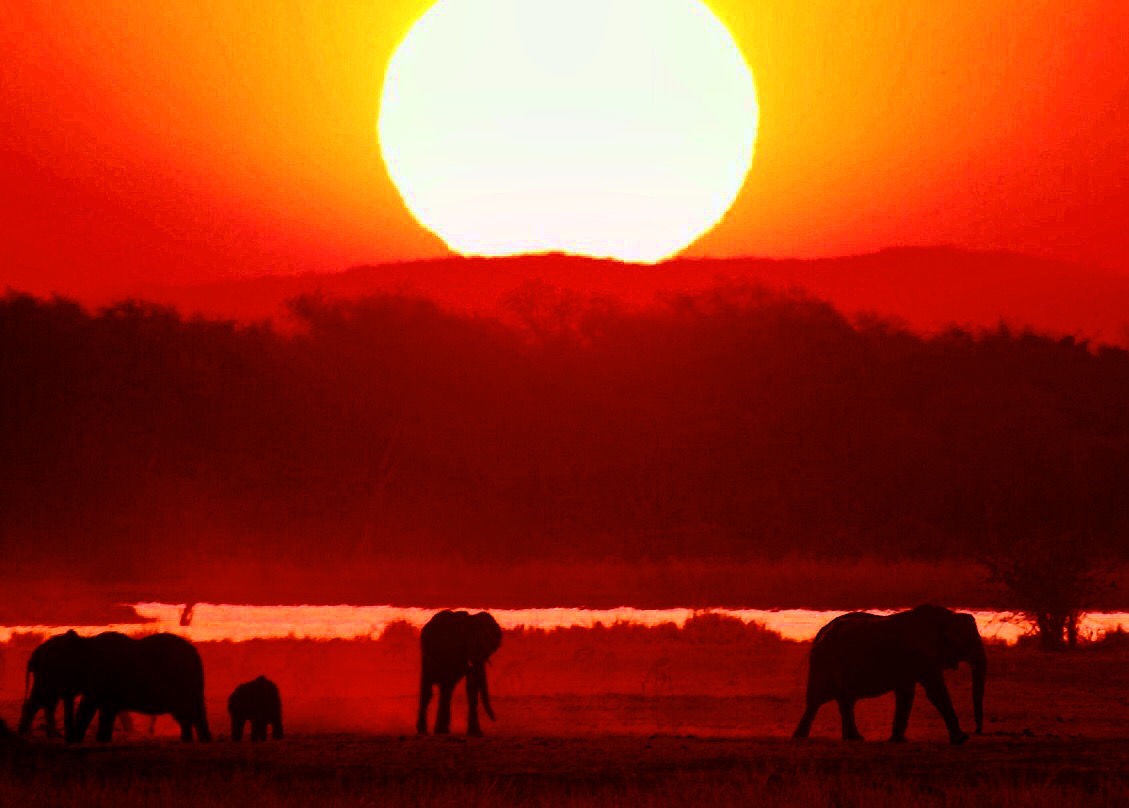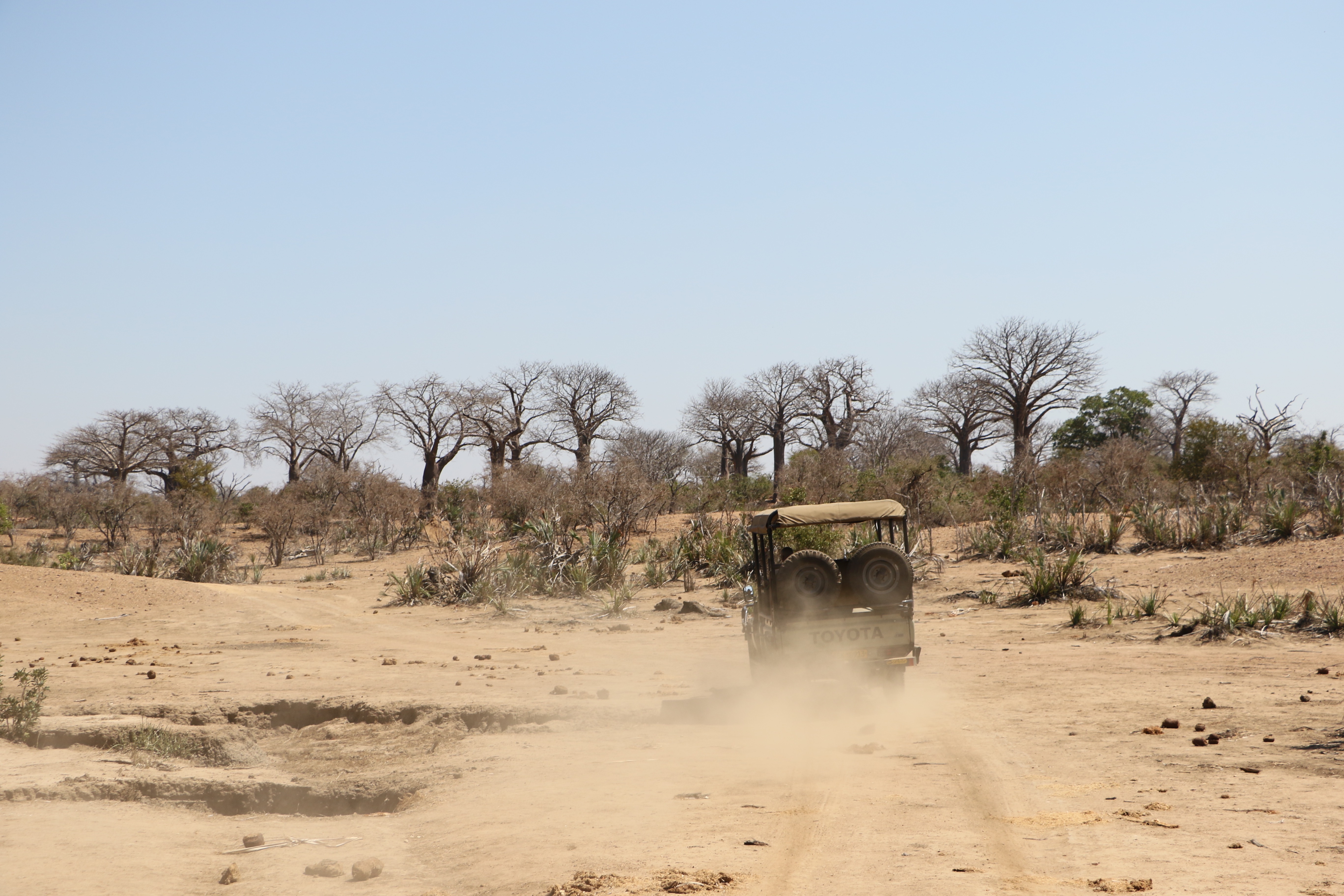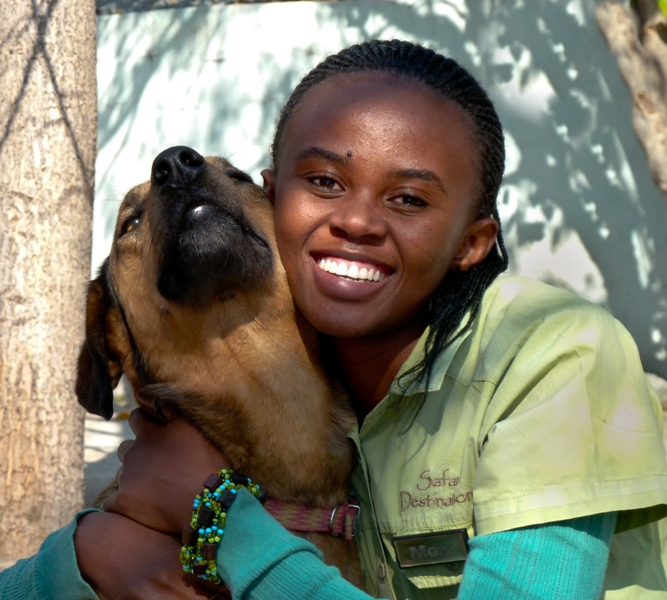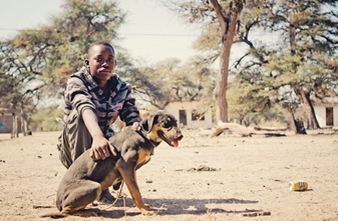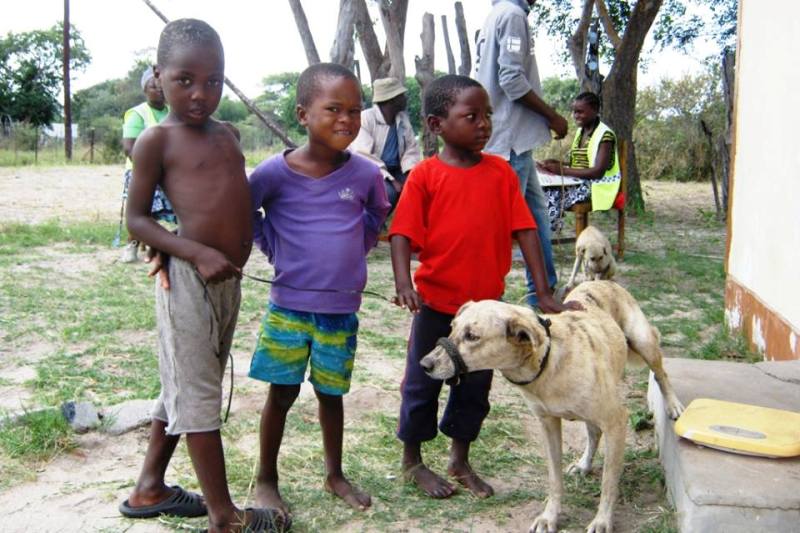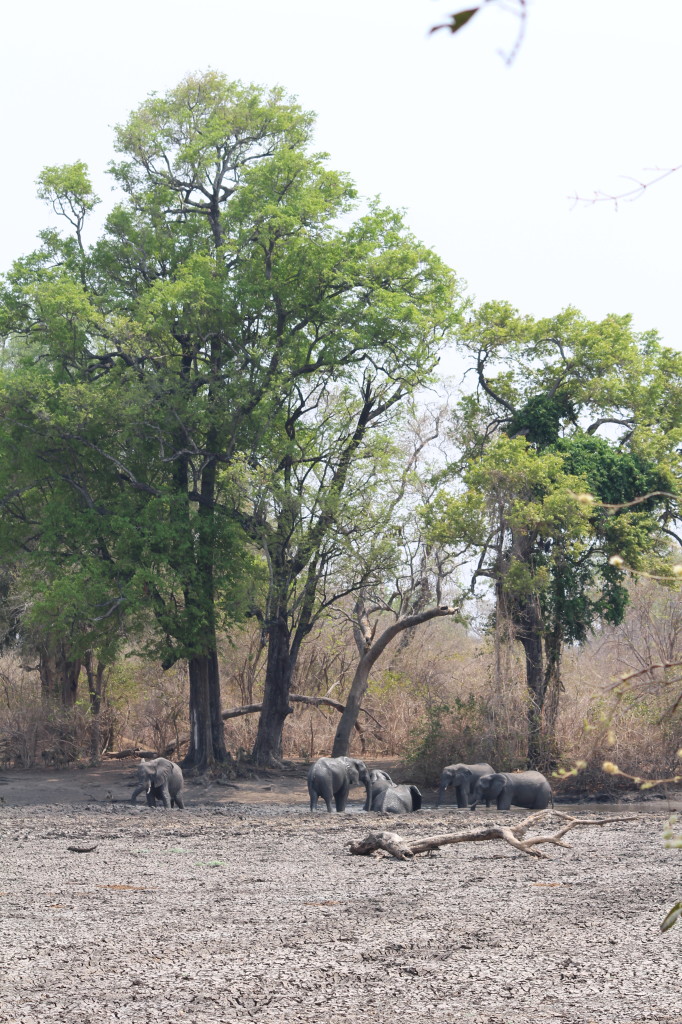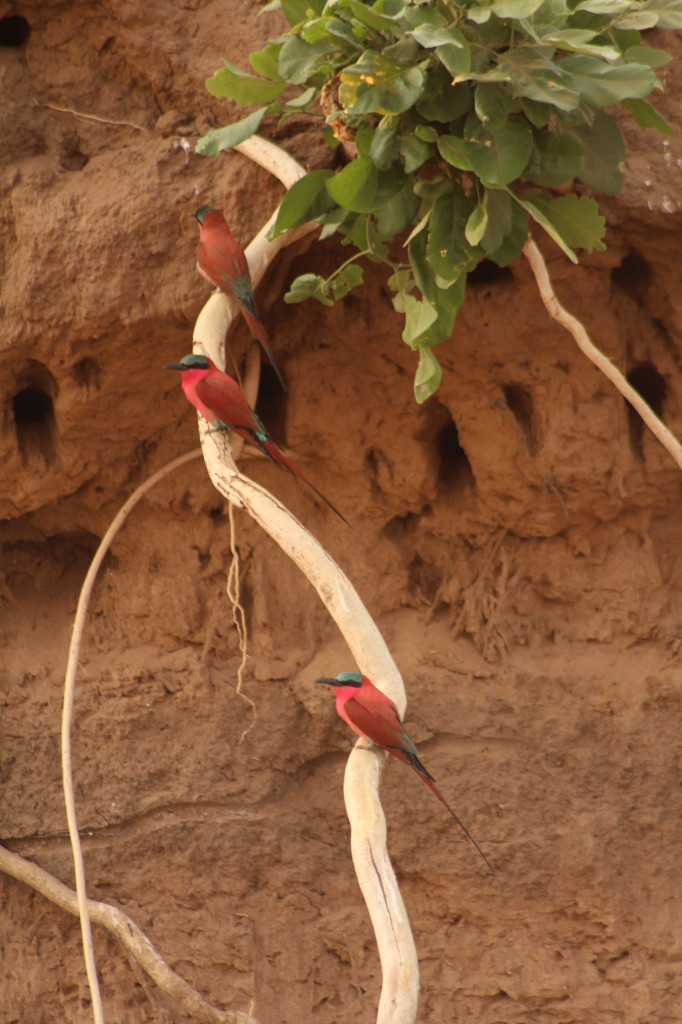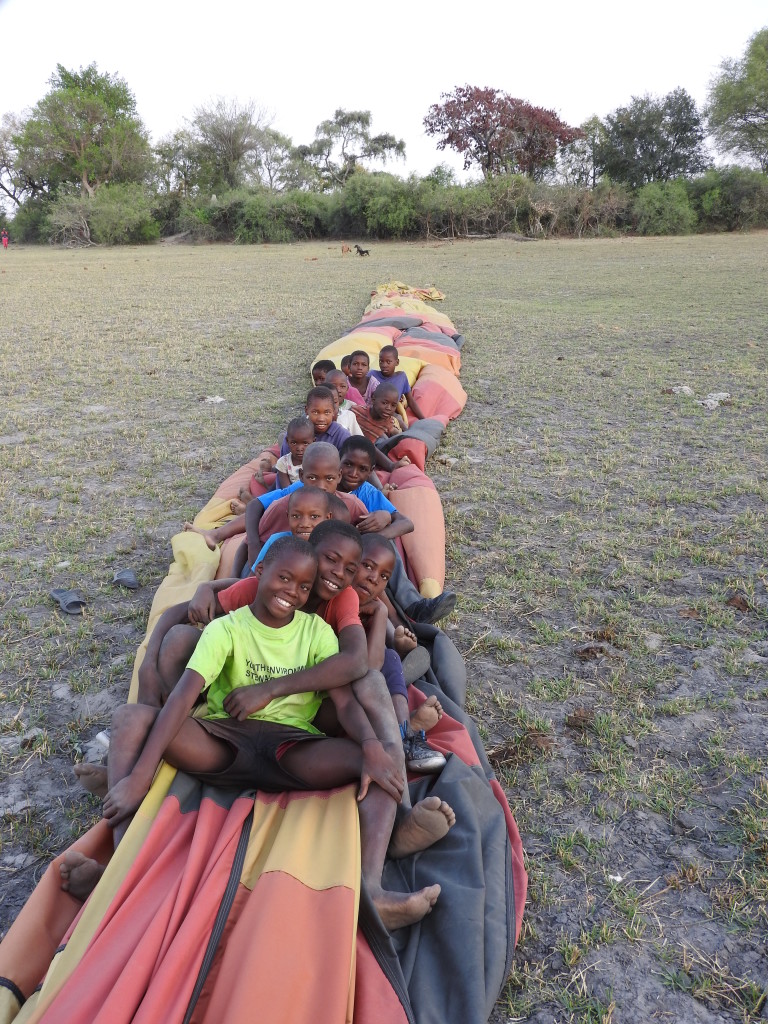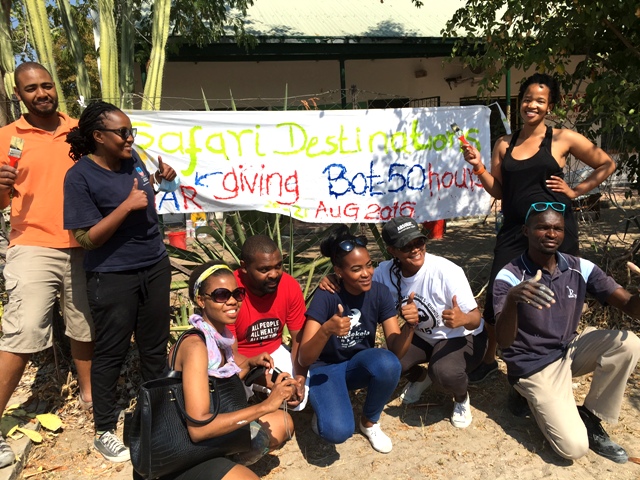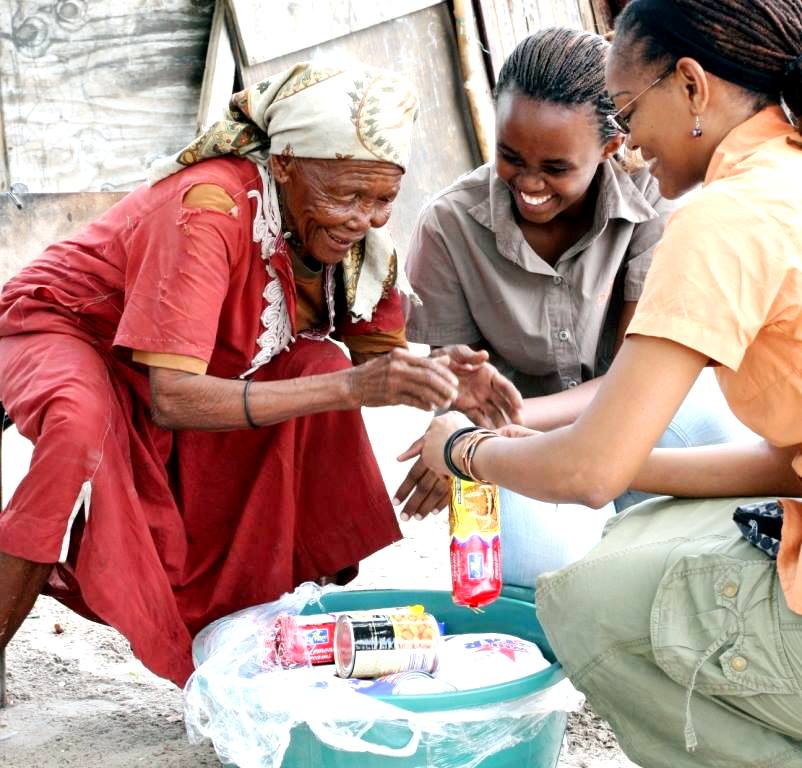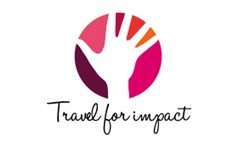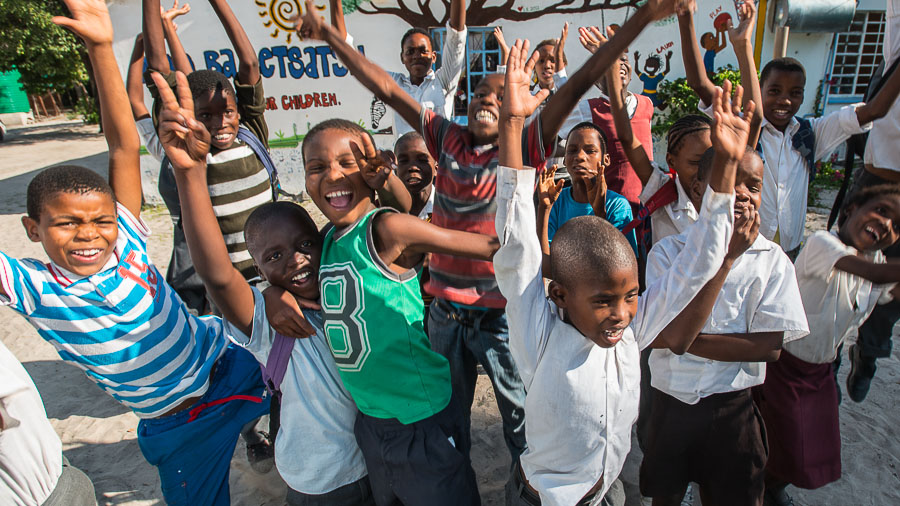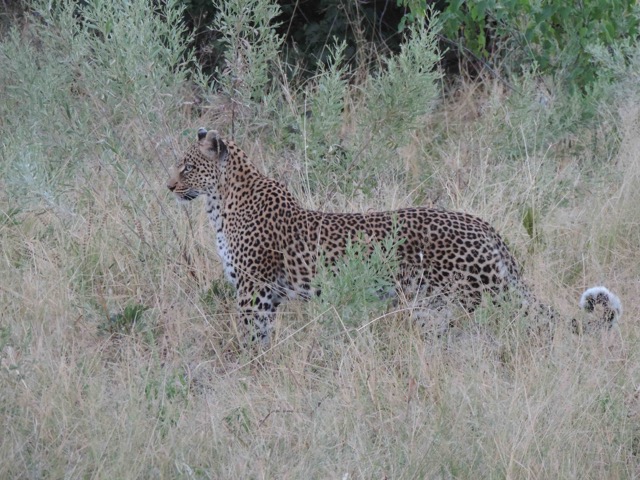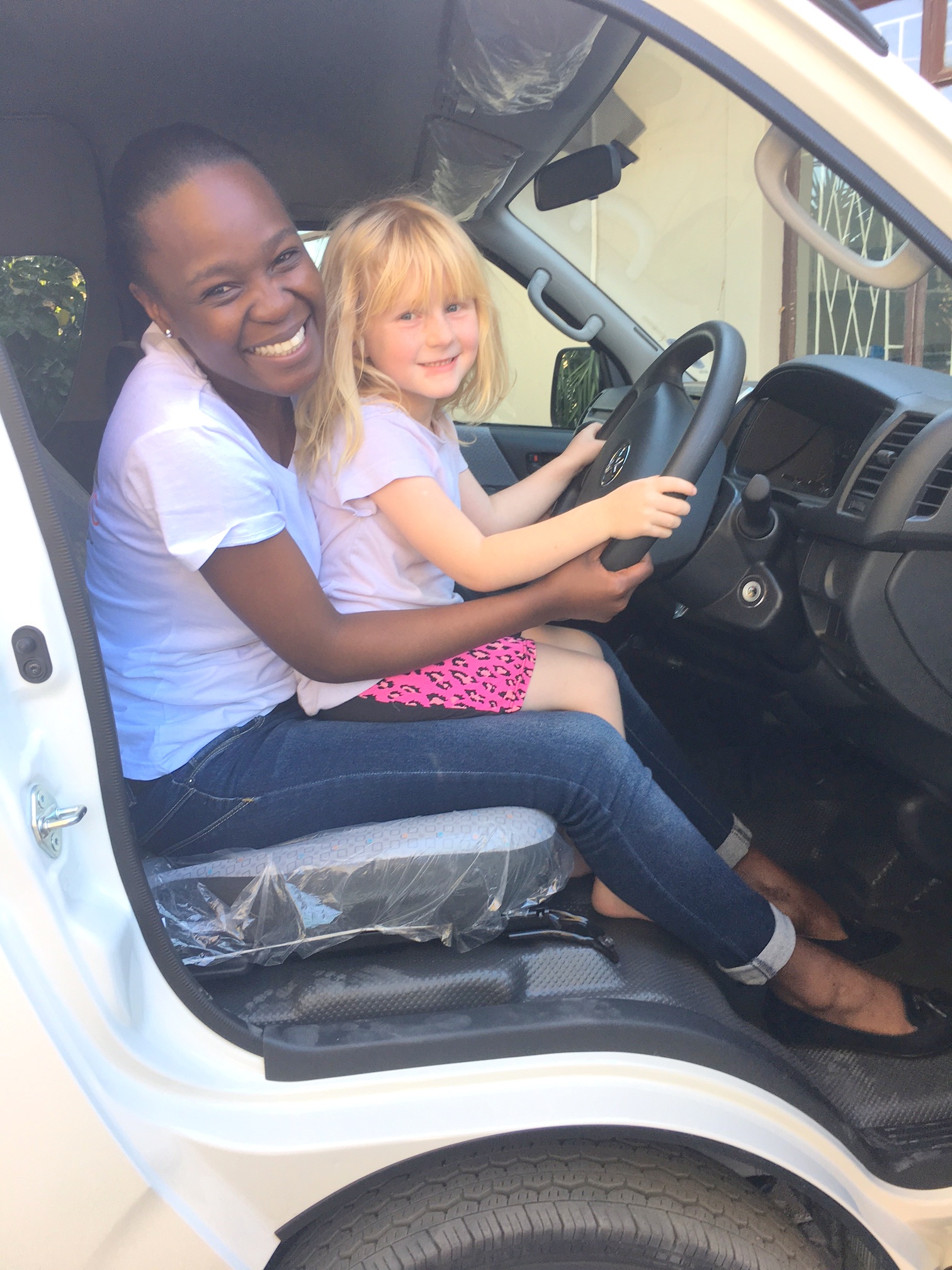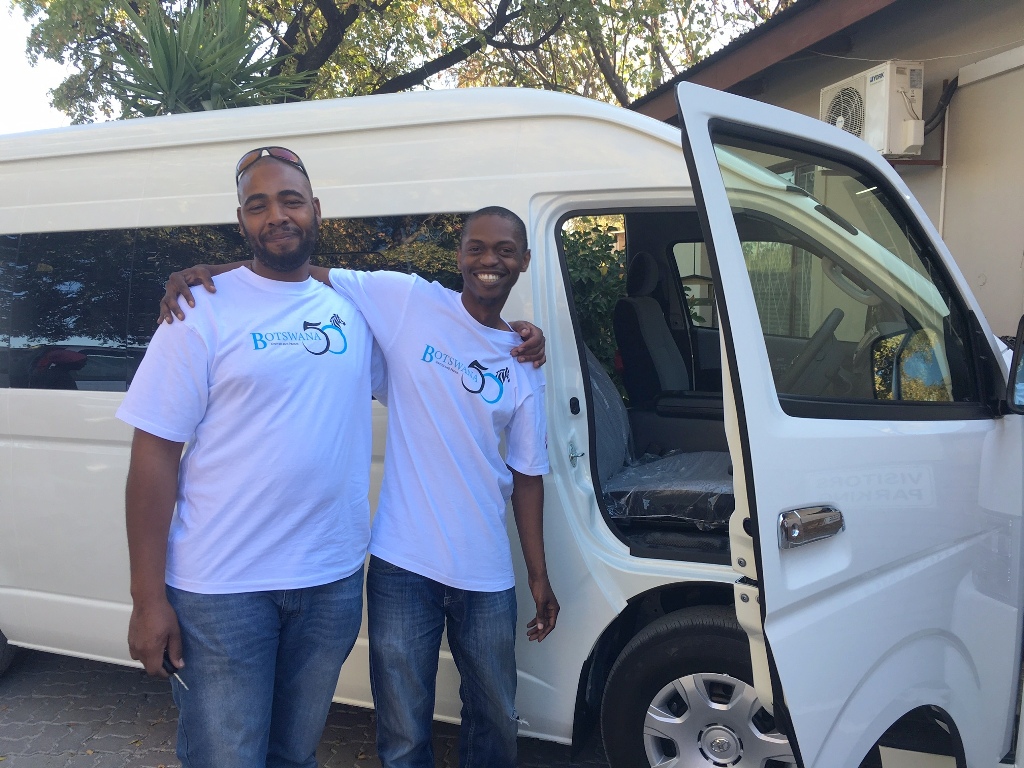The simple pleasures of travelling in Green Season
I was fortunate enough to spend a week on safari during our so called green or secret season. Everything seemed to be bursting with life, from the lush green bush to the intermittent cloud bursts that warned us of their impending approach and of course there were babies – everywhere! I don’t ever recall seeing a giraffe that small or the tiny blue wildebeest that was even smaller than the average Impala. The weather was perfect. It was certainly not a sweltering and unbearable heat and when it did rain (which of course was every day) it was more often over in an hour. Undoubtedly the biggest drawcard is the price tag as green season is the cheapest time to visit Botswana. 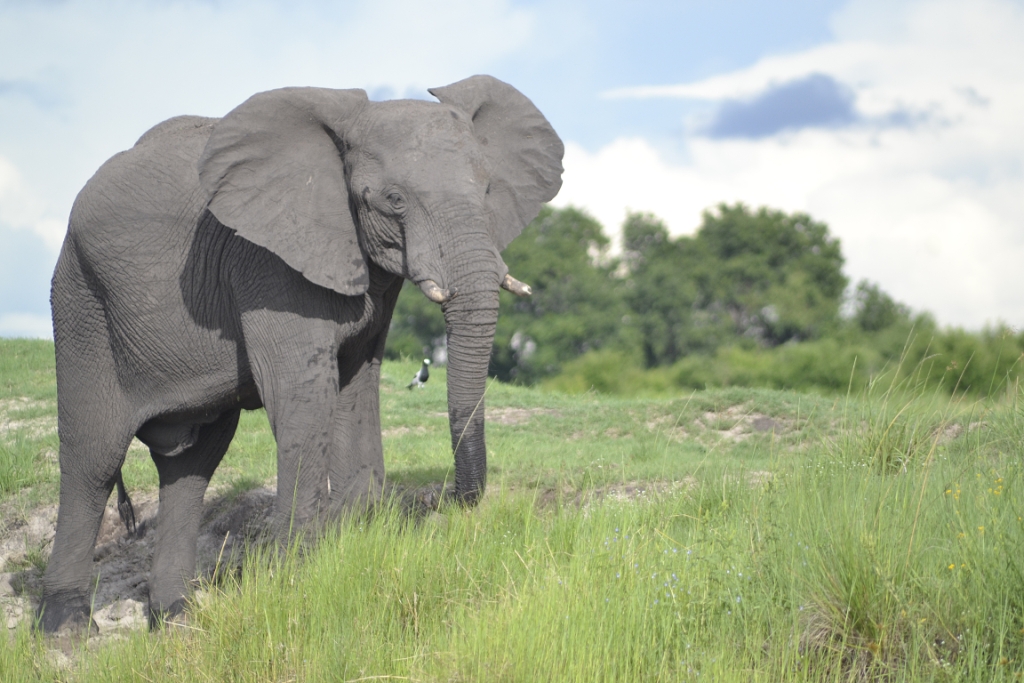
My journey started in Chobe but this time it was a completely different experience from my previous visits. I had the pleasure of staying on the Chobe Princess for the night and often this option is overlooked when starting or ending a safari in Botswana, yet it was the most relaxing and certainly the most rewarding game viewing experience. Feet up and reading a book, I would glance periodically at my surroundings only to find crocodile sunning on the bank, or a hippo out of the water. In fact it gave new meaning to the size of these animals, seeing them plunge from the bank into the water. Our guide took us out on a tender boat later in the afternoon and we watched a herd of Elephant come down to the water’s edge – expecting them to quench their thirst and move on. But we witnessed something I had never seen before amongst elephants… whilst I had seen them in water before this time was different as 3 young bulls cavorted and tumbled around, disappearing completely under the water for a moment before resurfacing. The only obvious sign would be the trunk peering out every now and again. I loved every minute of this spectacle.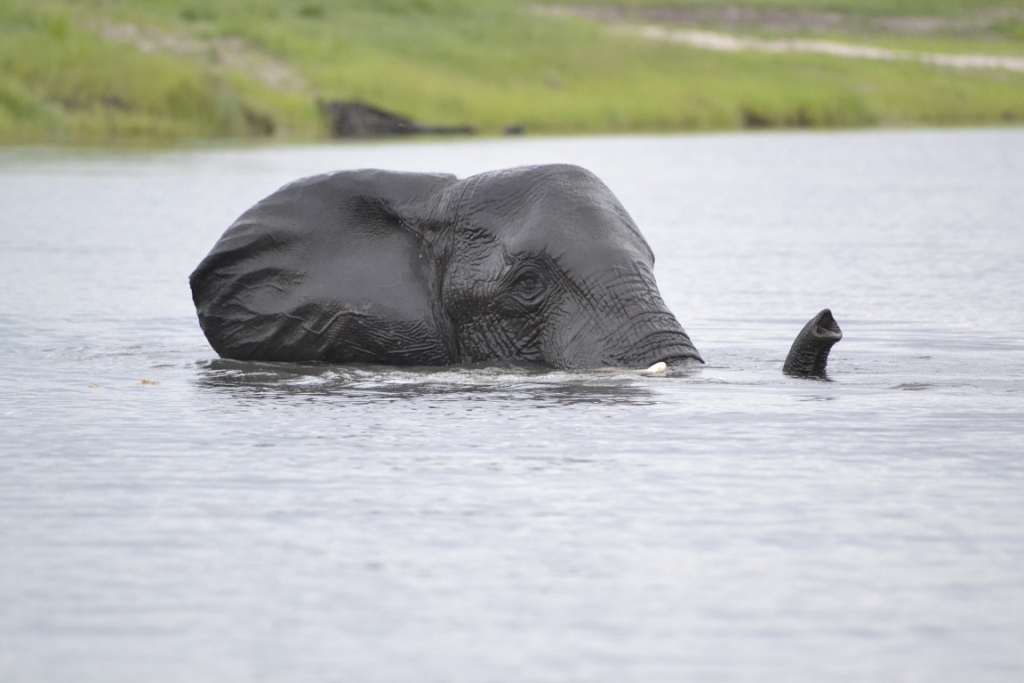
The highlight of my week away had to be the Xaranna concession in the Okavango Delta. With an expert guide and tracker to take care of our safari needs, we managed to see the Big 5 in 24 hours. Whilst this might be the normal expectation for most, very few concessions have the endangered Rhino. Through various means, White Rhino have been relocated from South Africa and reintroduced here over a period of time. It was certainly a proud moment to come across the magnificent prehistoric looking animals grazing peacefully in the bush nearby. 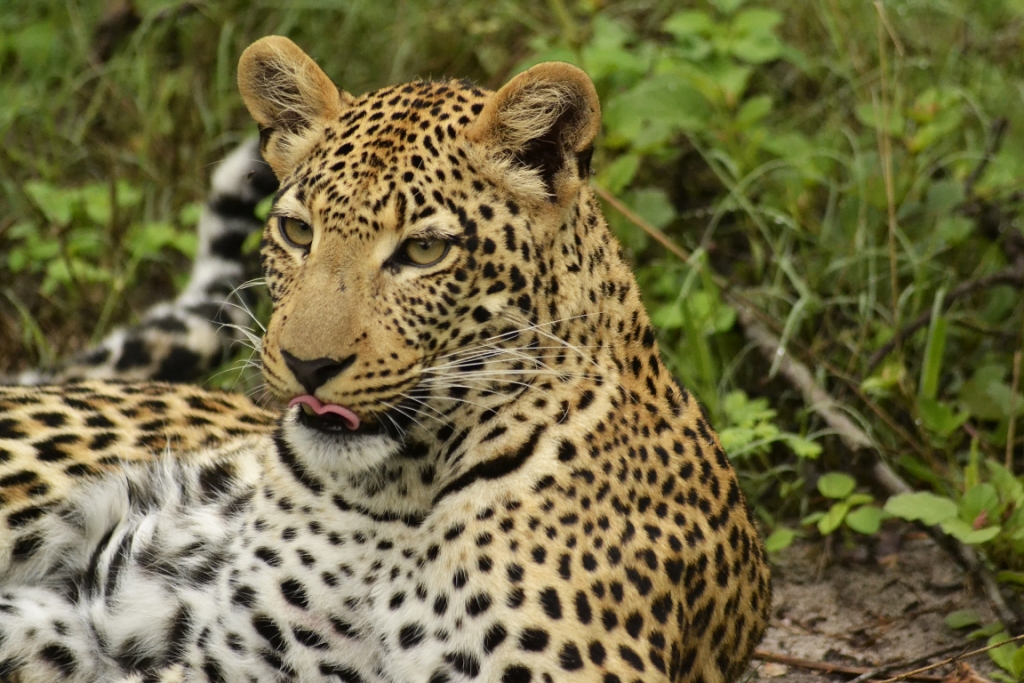
The rain showers did not keep us from our game drives and with a poncho readily available we embarked on both the morning and afternoon activity. The Delta was teeming with wildlife and though more scattered during the wet season, we were never disappointed. My husband, a professional photographer, commented on photography during this time of year, claiming that with less dust particles in the air, clarity in photographs was certainly better. I can only agree based on the stunning images he captured! 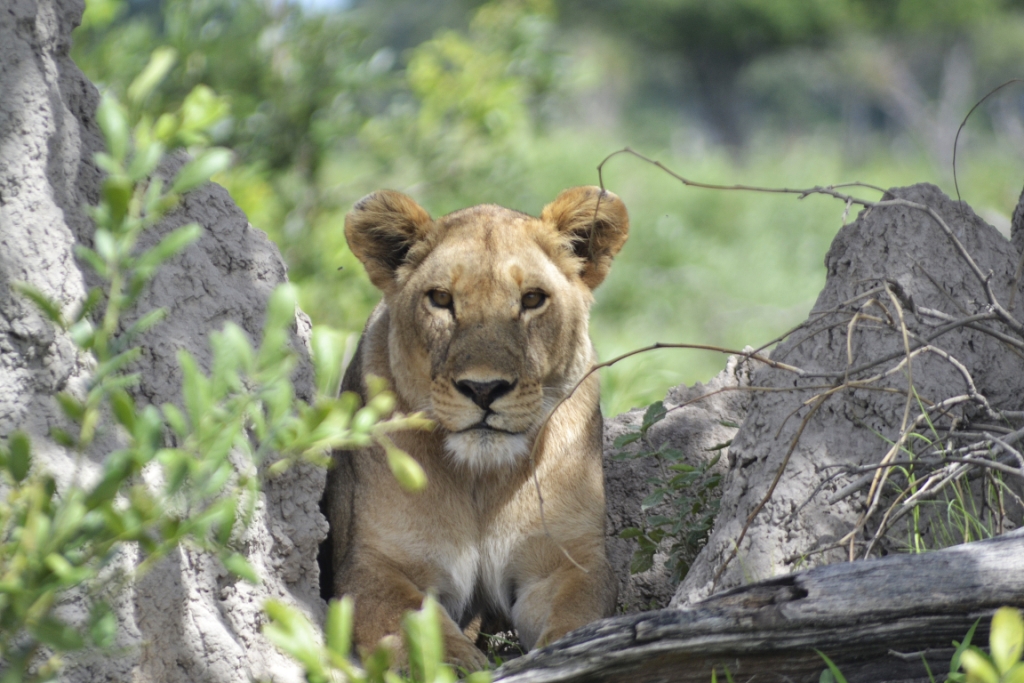
So in a nutshell, it will rain and probably more often than not. But with that comes the reward of new life, little lives finding their way; explosions of colour from the ground to the sky; a photographic playground; warm summer days and lastly a little more money in the bank account. 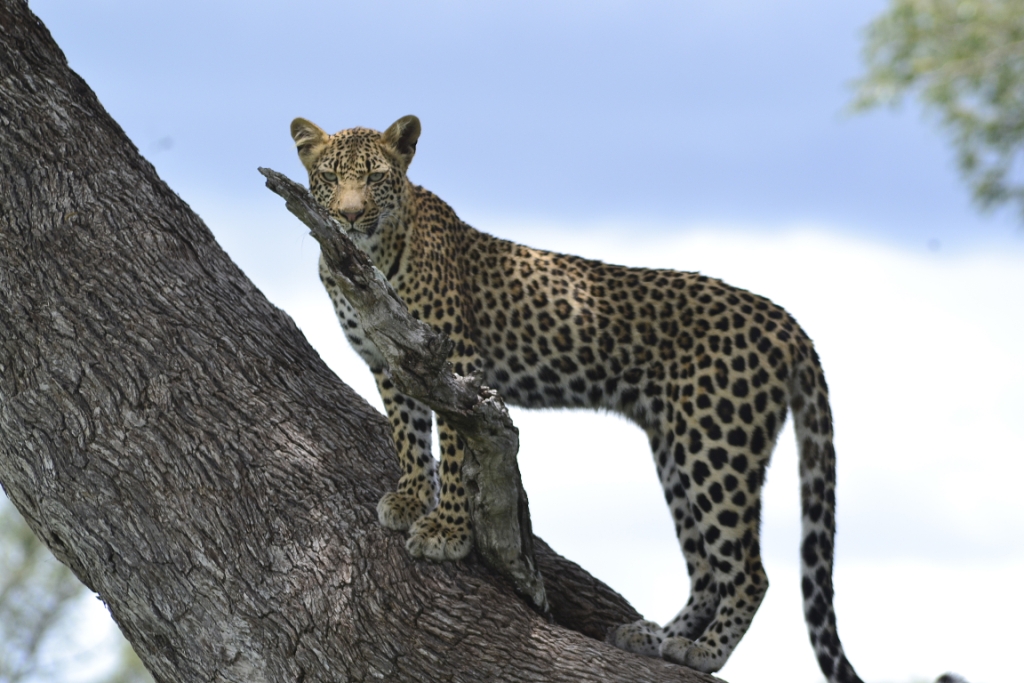
Should You Visit Zimbabwe?
It’s incredibly hot, and unreasonably dry in Hwange. As I sit and wipe the September salt from my eyes (in any other month it might be sweat, except the moisture evaporates before it can form), I wonder if a bikini might’ve been more sensible game drive gear, rather than the standard-issue khaki I’ve got on.
Typically, the argument for well-intentioned shades of light green and tan is that it’s practical. It’s sensible for bush walks, the lions won’t charge you (since you can convincingly impersonate a bush) and you can’t blind fellow safari goers with offensively clashing colour combinations. The problem though, is that as soon as your sweaty thighs have been rubbing on a canvas-covered seat for three hours, hey presto, you’re half transparent. Come sundowner time, I’m going to have to stand up and risk my fellow safari-goers thinking I’m incontinent – despite the fact that I’m a good two decades younger than most of them.
These are the superficial thoughts cruising through my pan-fried mind as we come across a breeding herd of elephants on the Dete Vlei Line. My mind is wandering, until these guys who had seemed pretty chilled at first, start forming a circle around a small calf, and then push two three year olds behind one of the bigger ladies in the herd. The matriarch stares at us, measures our composure and assesses the potential threat we pose. To be fair, they’re just as hot and bothered as I am, probably even more so. It’s been a long, dry winter, which is now heating up tremendously as the summer months approach. The bush is bare, there’s very little food, and the rain required to grow a larder large enough to feed 40,000 elephants is still at least a month off.
“These guys are under stress at the moment’ our guide “Zimbo” explains. Officially, we could put this down to another long and stressful dry season. Unofficially, Zimbabwe’s government have been separating the youngest members of Hwange’s breeding herds from their families and rounding them up into bomas where they’ll be housed before being shipped off to Chinese zoos, ‘the government says it’s restocking Chizarira National Park,” Zimbo says, but we soon find out they’re only capturing the youngest members of Hwange’s herds. This is not standard policy if you plan to re-stock another park with dwindling numbers of elephants. You just don’t leave behind the adults who’d need to school their young in the art of bush survival against a new and unknown terrain.
If you’ve ever spent more than a few minutes with a wild elephant, you’ll know how intelligent they are and how strongly they cling to their social structures. To an elephant, family is more important than anything else. Not only that, but elephants are intuitive enough to know when they’re under threat. From the second we pulled up, these guys were busy determining whether we meant to take their young or not.
Suddenly, the dilemma of my sweaty chaffing and temporary discomfort pales into the background. I’m left staring a serious conservation issue in the face – one that polarises people into different camps of opinion about whether or not to travel to Zimbabwe. This is an issue that requires more than “likes” and “dislikes” on social media, and Zimbabwe’s tourism industry is thoroughly aware of it. Not only that, but Zimbabwe’s operators are passionate about the fight, and actively seeking out conservation-minded solutions – if only they had more tourism dollars to do it.

One of Hwange’s elephant calfs makes short work of a lodge swimming pool’s water during the dry season this October.
THE MUGABE EFFECT
Everybody loves a baddie. Ask around, and you’ll quickly find Mugabe is the kind of guy people love to hate. Bob’s talent for misappropriating public funds may not out-match that of South Africa’s Zuma, nor might his brand of tyranny overshadow Russia’s Putin, but he’s certainly had the benefit of a few more decades to hone his reputation, as well as to develop a hefty anti-following.
Thanks to Bob’s surly disposition, and his refusal to govern Zimbabwe by usual democratic methods, there are many travellers and tour operators who feel a moral duty to discourage travel to Zimbabwe. On the surface, the motivation to do this seems noble – starve the guy of cash and knock him off his high horse. The problem with this approach is that it ignores two very significant factors.
#1: MUGABE DOESN’T NEED YOUR MONEY
He gets enough from the exorbitant taxes imposed on his citizens and the decades of foreign aid he’s already whittled away into bank accounts abroad. Mugabe’s pension fund is well and truly established, despite his lack of intention to ever really retire. A lack of income from tourism will not be the motivating factor that prompts old Bob to secede.

Mugabe might be a menace, but his antics are transparent enough that most Zimbabweans can get the best kind of humour out of a bad situation
#2: ZIMBABWE NEEDS YOU
Of all the places I’ve travelled in Africa (and I’ve been to 21 of her countries – which is not all of them, but it’s enough) I’ve never met more committed and passionate conservationists than what I’ve found within Zimbabwe.
Zim’s lot are a tight-knit bunch, who for many years have drawn together under dire circumstances, made a plan with whatever they’ve got to hand and often used nothing more than sheer bloody-mindedness to protect their natural resources against an alarming lack of support from their own government.
Zimbabwe’s tourism operators have taken on the task of grading and maintaining roads, both for anti-poaching patrols, as well as to establish game drive networks. They pump waterholes during the dry months to keep wildlife sustained and to prevent populations of already threatened species diminishing even further. Zimbabwe’s tourism operators use significant chunks of their income to feed, educate and employ people from villages bordered by wildlife areas, in an effort (which has been shown to work) to curb subsistence poaching.
Ask any Zimbabwean operator and you’ll find that the battle is not just hard-won, it’s also funded by tourism dollars alone. Without the much-needed cash injection from tourism, waterholes would run dry – killing wildlife, safari camps would go abandoned – opening up tracts of land to unchecked poaching, and Zimbabwe’s natural resources, as well as it’s people, would face an even more uncertain future.
With the help of tourism dollars, Zimbabwe’s safari operators are able to help fill the void left by a negligent government. If you want to have the greatest possible impact on Zimbabwe, then visit – and empower its people to achieve even more, in spite of the man up top.
THE GUIDING IS UNBEATABLE
Until a couple of months ago, if you’d asked me how I might react to standing in front of two lionesses on foot, I’d tell you I’d love to do it, but I’d anticipate feeling a little bit shaky about it. Add to this a big male lion that would be SOMEWHERE around, but we wouldn’t be sure QUITE where, until he grumbled from the bush behind me, and I’d be happy to guess that it would be brown trousers time. Somehow though, when faced with the situation in reality – that’s not how it ended up playing out.
Earlier in my safari with Singita Pamushana (in an under-appreciated corner of Zimbabwe called Malilangwe) our guide Mark had introduced us to his tried and true method for fitting in with the wildlife. “I talk to them, ok? You might think it’s weird, but for me, it works. The trick is never to sneak up on a lion. Always let him know you’re there. I’ve been doing this for years and the guys here (he was talking about the wildlife) are used to my strange ways. Just bear with me.”
And so it was, that I found myself in the middle of a casual chat, when I would’ve expected to feel a cold sweat coming on instead. “It’s OK big boy. It’s alright.’ Mark says ‘We’re going. Don’t worry. We didn’t see you there. We’re just going to go now, ok?’ then, as our lion continues rumbling, flicking his tail back and forth as if Mark has just made a pass at his lady friends, he instructs us ‘ok, we’re going to leave him now, he’s a bit grumpy, just follow my lead.” Despite the theatrics, Mark had made such light work of the situation that I didn’t even skip a heartbeat. In some ways it was a little disappointing not to feel the expected rush of adrenaline, but in reality, it was also a pleasure not to have to deal with the extra laundry.
This is the talent of Zimbabwe’s guides. They spend years and years training under a system so rigorous that it’s gained a kind of notoriety. Ask any experienced guide whether they’d like to sit Zim’s test and it’s almost guaranteed that the idea will give them a kind of buttock-clenching anxiety. Guides in Zim are expected to know all sorts of everything, from biology, astrology and geology, to exceptional hospitality skills. Ever had a guide climb over the top of you, into the back of the vehicle, so he can pour everyone gin & tonics at sunset without having to drive away from an impressive lion sighting? I have, and it only would’ve happened in Zimbabwe (kudos for this trick go to Albert of African Bush Camps).
In Zimbabwe, you’ll learn the personal stories of the wildlife you encounter, including everyone’s names and what their family trees look like. It’s exactly this in-depth level of guiding that drew such attention to the plight of Cecil the lion, famously shot in Hwange a year and a half ago. Cecil’s story drew such ire because he was well-known. People who visited the park knew his story intimately because of the guides who shared it with enthusiasm. Cecil lived a soap-opera life of tenuous coalitions and love affairs, producing a very tangled family tree that the park’s guides keenly traced and continuously re-told, as if taking the proverbial skeletons out of their own closet. By the time Cecil was shot, he’d been made famous only through the enthusiasm of Zimbabwe’s guides. The conservation plight highlighted by Cecil is real, but were it not for the commitment and passion of Zimbabwe’s conservation heroes, it would’ve gone largely untold.
AND, ZIMBABWE IS OPENING UP
While Zimbabwe has had some pretty quiet years since hyperinflation, the number of visitors to the country (particularly Hwange and Victoria Falls) have picked up tremendously in the past few years. New camps are opening up, providing even more options for different travellers on different budgets, from honeymooners to adventurers to families. Zimbabwe has a wealth of contrasting landscapes to explore, from the dry grasslands of Hwange to the mountain-dominated backdrop of Mana Pools, and the ever-impressive Victoria Falls, which keeps change as its one constant, throughout all the seasons.
For the intrepid explorer, Zimbabwe offers so much more than a safari – it’s the history in its UNESCO world heritage sites – from the balancing rocks of Matopos to the medieval ruins of Great Zimbabwe. It’s the rugged landscapes ready for hiking in the Eastern Highlands, the baobab-filled villages that’ll fill your view in the rear-view mirror, the gritty city scene of Harare and the first lightning storms of the year rolling out towards your houseboat across the open waters of Lake Kariba.
Best of all, even in high season, you’ll still find you’ll have most of Zimbabwe completely to yourself. Surprisingly, the masses still don’t seem to have realized what Zimbabwe has to offer – and, if nothing else, you’ll take home a better lesson in conservation and a more comprehensive understanding of the challenges our planet faces than what you’d get in any other country having a much easier time of it.
The Maun Animal Welfare Society (MAWS)
October is behind us and here in dusty Maun we are all praying for some rain to break the seemingly unending heat we’ve been enduring . October in Maun is known for Three things: One, the aforementioned heat, Two the aforementioned HEAT! and Three, Halloween. Yes, Halloween, a traditionally American festival, reaches our parched corner of the globe thanks to MAWS. Every year the team from The Maun Animal Welfare Society (MAWS) create a spectacular Halloween Village which attracts the Maun kids (and adults) in their droves. It’s a fun event and one which raises much needed funds for their on-going projects.
This leads me neatly onto the subject of MAWS, the job they do, and the reason SD supports them through the TFI Bed Night Levy.
On the face of it, MAWS, to some, is not an “attractive” organisation to support. When it comes to community involvement, people mainly – and not necessarily incorrectly – focus on the human issues. It’s also true that many countries around the world have equal problems with stray domestic animals, so supporting an organisation like MAWS often becomes a lesser priority when faced with greater challenges.
So who are MAWS? In a nutshell, they provide free veterinary services to low-income villagers across Botswana. They have sterilised and vaccinated tens of thousands of dogs to reduce breeding and disease, and fitted reflective ear tags to thousands of donkeys to prevent night-time traffic accidents. They also reunite, rehome, and rehabilitate lost, found, and stray animals, and provide emergency treatment.
What is less know, but of vital importance, is that MAWS play a crucial role in preventing the spread of disease from the domestic animal population to our world renowned wildlife. To quote the Botswana Predator Conservation Trust:
“The management of domestic dogs in rural Botswana cannot be overemphasized. Uncontrolled and unmanaged domestic dogs are not only a risk to human health, but also, importantly, to neighbouring wildlife populations – a fact widely unrecognized by the international community. Botswana’s rural areas depend almost entirely on the rich natural resources and wildlife for which the country is internationally recognized. But common and contagious domestic dog diseases and uncontrolled hunting of native wildlife by uncontrolled domestic dogs severely threatens these important wildlife resources.”
Support for MAWS is not limited to the Predator Conservation Trust, Internationally recognised conservationist; Map Ives endorses MAWS programmes as does Cheetah Conservation Botswana.
MAWS visit rural areas where villagers live side-by-side with wildlife. Their work helps to prevent the transmission of rabies and canine distemper: diseases which can decimate wildlife including the African Wild Dog, lions, leopards and cheetahs.
As a Destination Management Company, Safari Destinations knows why visitors come to Botswana – to experience our stunning wildlife. It is for this reason that we continue to support this “unglamorous charity” in the knowledge that in so doing, we help in some small way, to protect and preserve our wildlife resource for future generations.
For more info, please visit www.maunanimalwelfare.com
Now…back to that fun Halloween event. Thanks to Kay, Resego, Karen J, Chawada, Mogamisi and Pam who all volunteered to assist at this year’s Halloween event. Their afternoon started off by buttering MANY MANY bread rolls…once they had found the elusive butter…that was in front of them all the time!! This was followed by the cooking process in earnest with Resego, Chawada and at a later stage Pam proving their super-human cooking skills (apparently they’ve missed their true career callings).
Nana Kay was moved off to sell glow sticks & tickets for the tombola and was then, according to her “promoted to my true position as wicked witch … placed at the exit of the Haunted House, to stop all the delightful boys that think it’s funny going in the opposite way and scaring the girls by climbing over rather than under the obstacles and generally causing mayhem. Obviously I was the scariest volunteer and they listened to me………………………..sometimes!!!”
Karen moved across to sell Glow Sticks with a constant smile and eyes in the back of her head as some very slippery characters were constantly hovering. Mogamisi, obviously had the most honest face of all as he was asked to help at the entrance, taking admission fees.
After a very long and hot evening our volunteers were able to congratulate themselves on a job well done and another group total of over 33 hours donated to community service.
#ItTakesAVillage
Mad about Mana Pools
One of my best safaris ever! I was lucky enough to visit Mana Pools in early October. We arrived after a 2,5 hour flight from Victoria Falls and were picked up by our guide. I was blown away right from the start! Why ? Because I drove through the bush with different types of trees and shrubs. I was quiet surprise that there is no grass in some area and it is only this beautiful ochre sand.
The mighty Zambezi River is the boundary of the park with Zambia and it is a paradise for hippos, elephants, crocodiles and birds, especially the carmine bee-eaters. On my boat cruise, always having the beautiful view of the Zambezi Escarpment in the background, I had the chance to experience the carmine bee-eater flying around me and to see their nests on the bank of the river.
I only spent a few nights in this beautiful national park. I stayed at the unique Kanga Bush Camp and the amazing Ruckomechi. Both camps are totally different and both are special and definitely worth a visit. I was lucky when I arrived in Ruckomechi to see a breeding herd of elephants with very small baby elephants crossing the river. For seconds they disappear under the water, is that not amazing to see this kind of behaviour?
During the dry season, some lodges pump water for the animals. Water is the source of life as we all know. It was great to see all the different species coming to have a drink. We had baboons playing around, elephants and warthogs mud bathing, impalas, zebras, kudu drinking…When the sun is down, some others species will come for a drink such as leopard, civet, genets and hyenas. 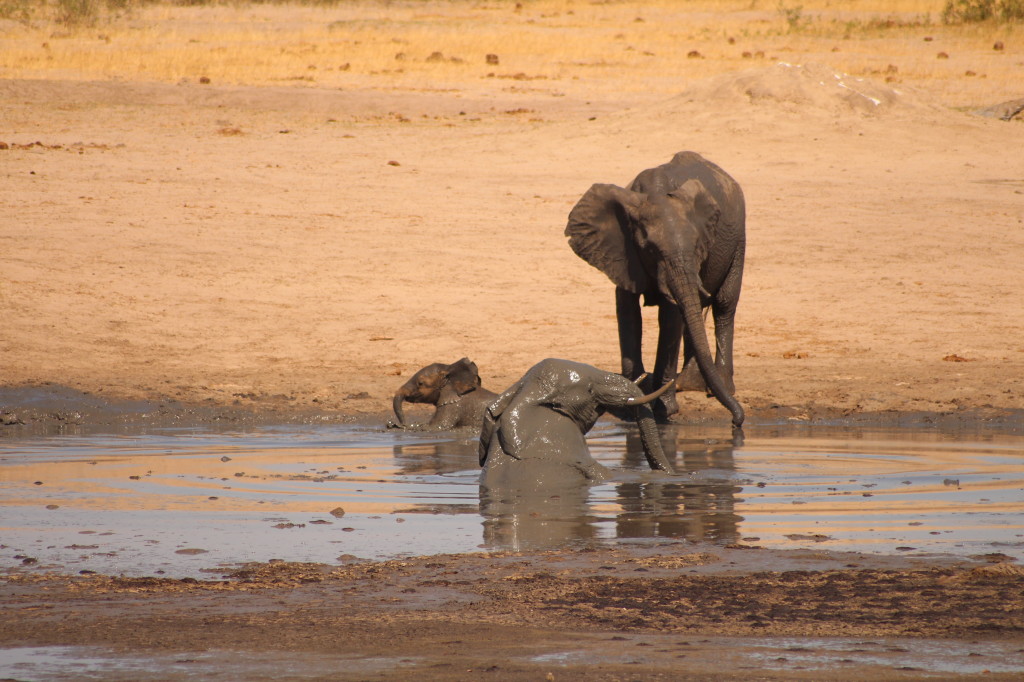
Mana Pools is captivating with the landscape, all the different species and the excellent guiding. I will definitely come back.
Spot The Bus
Maun Town Residents: The Community Bus is doing its rounds. Snap a Picture, Share it and you could Win!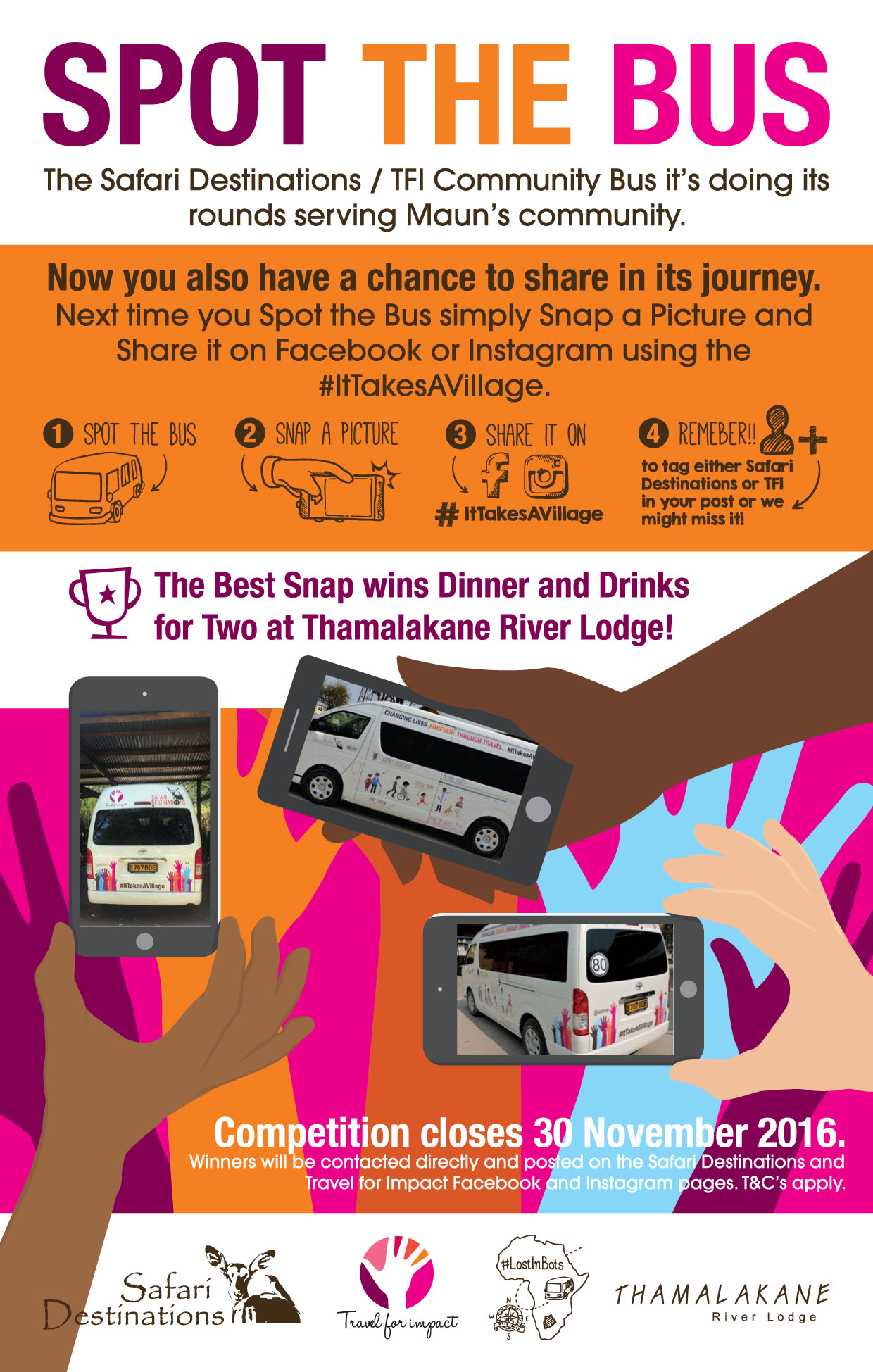
Fly, Fly Away…
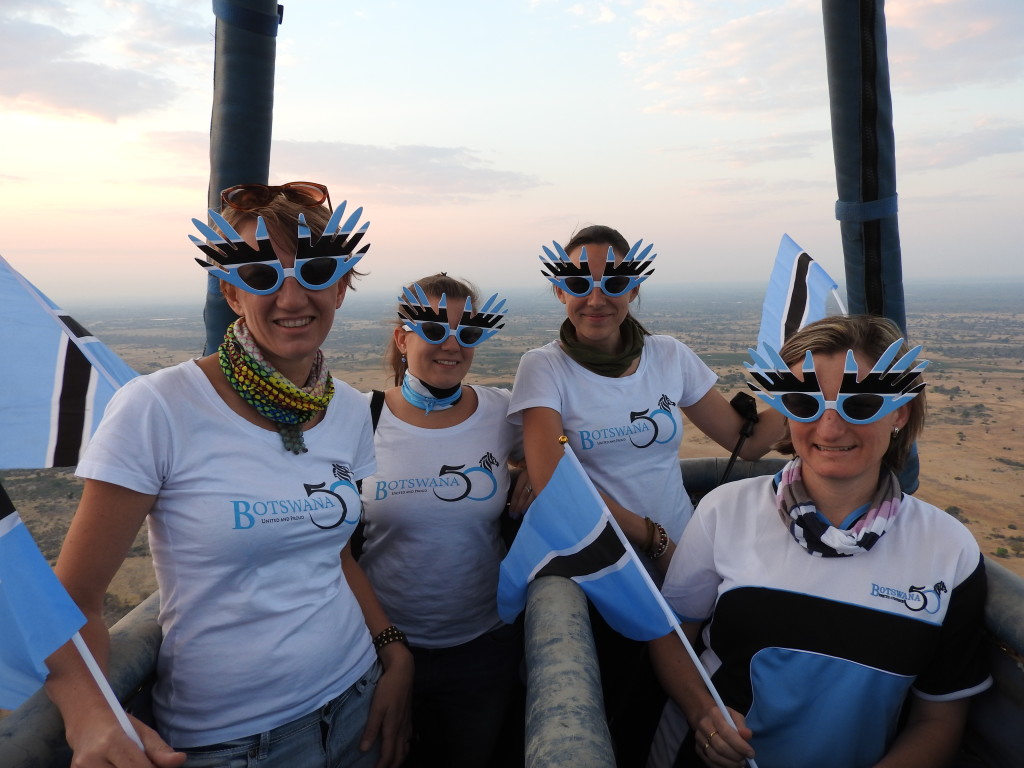
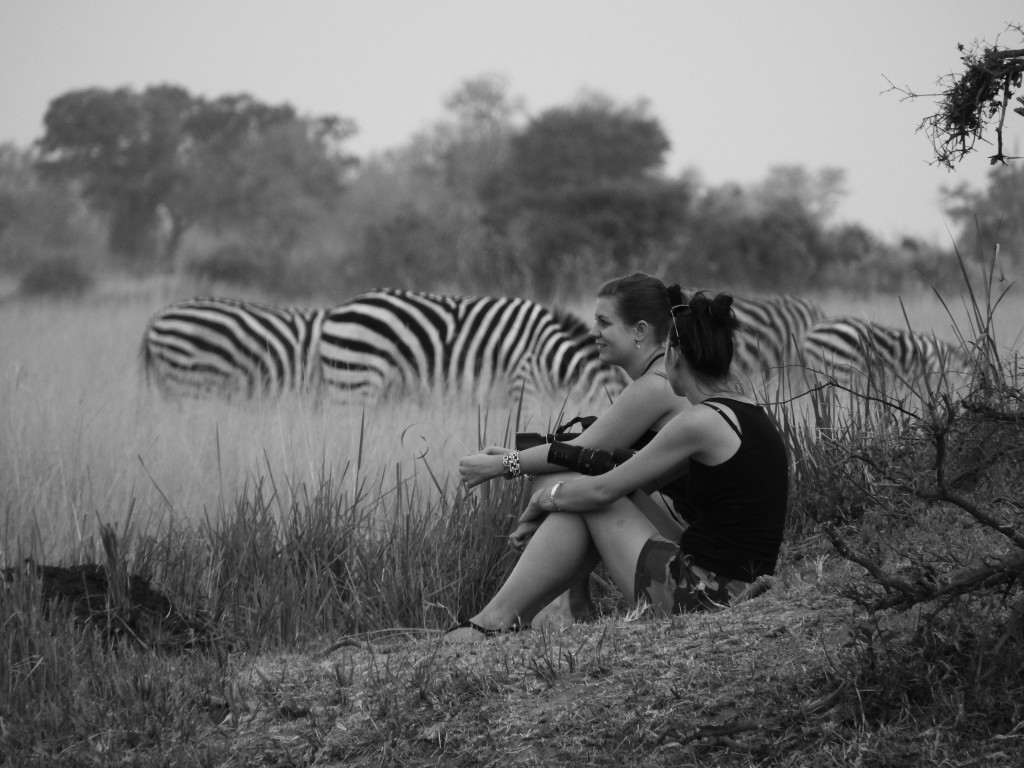
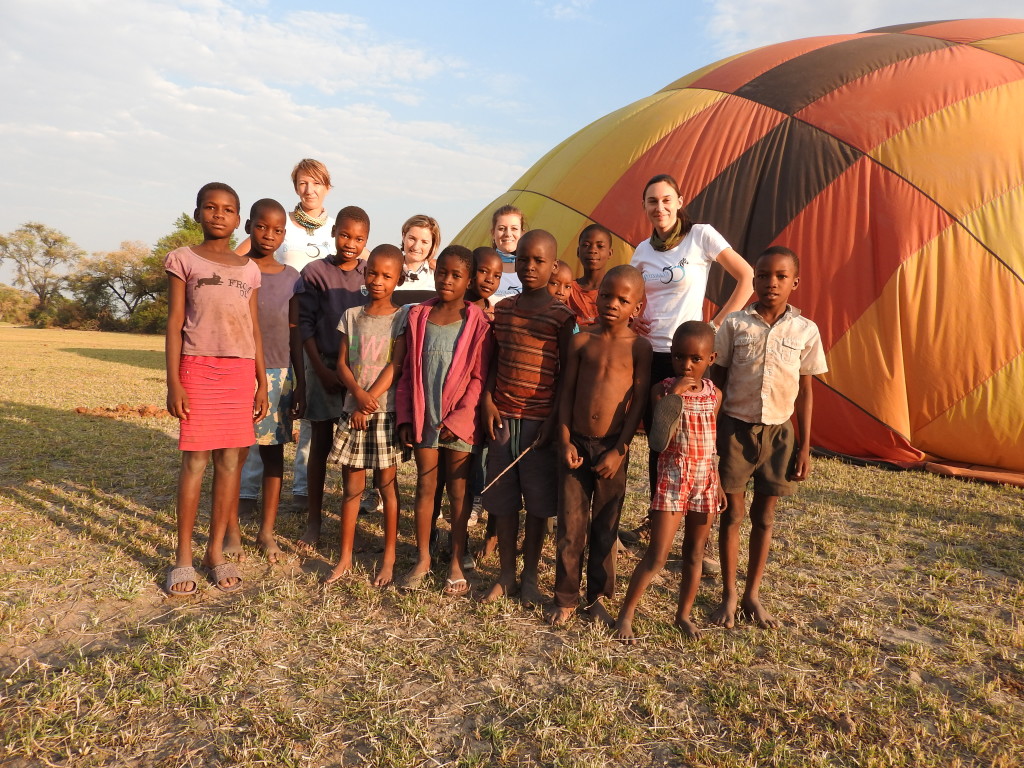
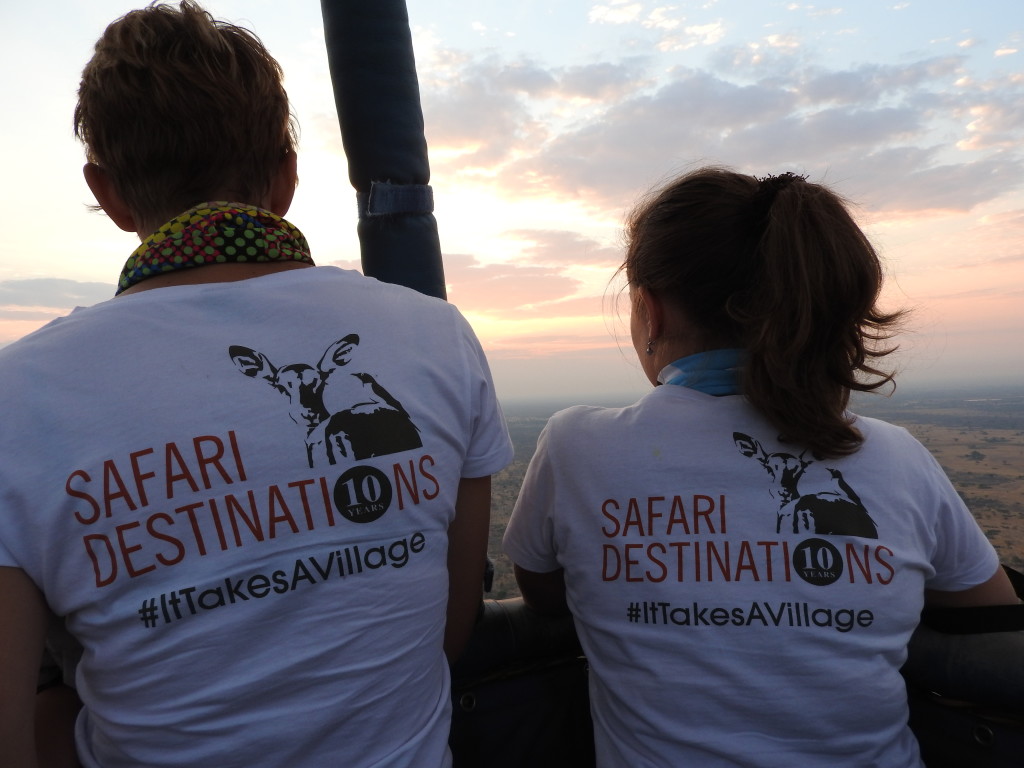
Community Hours Update
By now I’m sure almost everyone following our blogs are aware of our 10FOR50 campaign, celebrating our 10th and Botswana’s 50th anniversaries. A key component of our campaign is to donate 500 Hours to Community Service.
Our Team has been working hard on achieving our goal – so much so that in only four months we’ve already completed an impressive 305 Hours!
Our late August and September activities comprised a makeover of the reception at WAR (a local NGO offering safety and support to victims of gender based violence) and continued home visits to needy Elderly, identified by AGLOW (a local NGO providing support to the elderly). We also participated in local fundraisers and education campaigns: the Golden Groups Fashion Show and the Maun Global March for Rhino’s Elephants and Lions.
This month, we thought we’d share some feedback from our activities with WAR and AGLOW as related from behind the scenes by our staff members Angie and Chantal.
Chantal participated in Elderly visits with AGLOW. She writes the following moving description of what such visits entail:
“The things we take for granted in our lives were sorely lacking as Lesang the AGLOW coordinator took us to the first port of call. A dark hut, no windows, a few breeze blocks allowing in tepid light. A mattress on the floor being the only furniture, bar an old tin trunk. No modern conveniences here at all. An elderly lady in residence – semi paralysed by a stroke and with limited eyesight and hearing, greeted us from her bed clashing some metal sticks together, thinking that we were there to steal her things. Lesang patiently held her hand, and explained to her that we were here to clean her house, help her bath and wash her clothes, that we were there to help and not steal.
These are all simple activities to do, and yet difficult in an environment of dust, sand and no running water. We set about the tasks of fetching water from the office, sweeping an incomplete concrete floor crumbling to sand, and Resego breaking a broom in trying to air the bedding. All of us learning to speak loudly so that we could be heard and understood. Our elder helped to a seat outdoors, sat and ate the nutri-meal porridge which is one of her daily meals provided by AGLOW. She chivvied us on, strong and fierce in spirit despite the frailty of her body. Bathed, body lotion applied to the softest skin, and changed into fresh clothes, our elder gave thanks for feeling so much better after the bath.
We took small gifts – toiletries, sweets, biscuits – all were stashed away in a “safe” place and a hot meal eaten with relish. These were all simple things we did, and yet Lesangs’ patience and caring, her conversation and gentle touch reminded me of how much our elderly miss out on each day. AGLOW are striving to provide dignity, respect and care for a generation lost in the speed and demands of today’s’ world. I am proud that we, as Safari Destinations, support AGLOW. I have the greatest respect for what they are achieving and am humbled to have been able to assist in some small way.”
Safari Destinations is a proud supporter of AGLOW. In addition to assisting them with home visits, we also provide AGLOW with substantial monthly funding through the TFI Bed Levy. They will also benefit from free transport through the SD/TFI Community Bus, when launched in October.
Assisting and supporting vulnerable woman in our community is another core project in SD’s Social Responsibility Agenda. We were recently requested by WAR to renovate their reception area. Ops Manger Angie reports:
“On Saturday 20th August 2016, accompanied by our Director Lorraine, 10 of our staff members (the 1st of 2 Groups) took on the then barren walls of the WAR Reception area. With masks on our faces we sanded and scrubbed the walls tirelessly, interchanging tools, while others went on breaks to catch their breath.
As much as the day was filled with laughter and catching up with each other, this day was not about making up hours but about reflecting on the broader purpose of why we were gathered at Woman Against Rape. It was at the forefront of everyone’s thoughts that we were in actual fact making the environment, atmosphere and space for those who used this Reception area a brighter, happier and safe place.
The experience of working together as a Team towards one goal is priceless and the sense of accomplishment is very gratifying. When all was done and dusted and the paint was left to dry, our contribution for the day will forever resonate in our hearts as we gave way to our colleagues who completed the makeover the following day…
Every time I walk away from such acts of benevolence, I am reminded that serving with even the smallest tasks can make a difference in people’s lives and broadens my awareness to the next person in my community.”
We look forward to the coming months which will see us donating more hours of community service to other projects including: MAWS Halloween Fundraiser, Bana Ba Letsatsi Fun Day and the AGLOW Christmas party.
#ItTakesAVillage
Bed-night Bank
Announcing the arrival of Bed Bank For Charity – a ground-breaking, fund raising initiative by Travel for Impact and Safari Destinations.
Travel for Impact (TFI) and Safari Destinations are very excited to announce the ‘Safari Bed Bank’ – an exciting and innovative new venture to help raise awareness and funds to local community projects in Northern Botswana. The Safari Bed Bank complements the already existing work of Travel for Impact. TFI helps local communities on the ground, partnering with the safari industry to create a social responsibility fund which is administered through an advisory board comprised of community activists along with the private sector1. Not only do TFI provide financial support for community initiatives, they also add value by offering a dynamic range of mentoring services, strategic development and by sharing thier experiences to encourage these wonderful charities to meet their goals and to ultimately flourish through sustainability and growth.
Travel for Impact encourages the concept of ‘the wilderness supporting communities and communities supporting the wilderness’, driving conservation from beyond the immediate boundaries of tourism activity. Through generous donations from wildlife industries such as Safari Destinations, TFI already holds an impressive track record of helping and nurturing charities in making an impact.
The Bed Bank encourages suppliers to donate bed nights to Safari Destinations, who in turn sell these bed nights on, passing the proceeds to Travel for Impact to support charities with their core costs. As a Destination Management Company, Safari Destinations promotes Botswana’s accommodation and tourism services to the global market. Our position puts us in contact with both suppliers and agents. The ‘Bed Bank for Charity’ grew naturally out of these relationships and is an initiative which will have a lasting and meaningful impact.
Lorraine and Ruth, Managing Director of Travel for Impact, both recognise that this concept is only possible with the support of suppliers. Both companies would like to express their gratitude to the following companies for their generous support of the Bed Night Bank: &Beyond; African Bushcamps; Bushways Lodges; Belmond; Footsteps in Africa; Ghoha Hills Savuti Camp; Machaba Camp; Meno A Kwena; Wilderness Safaris; Ngamiland Adventure Safaris; Sanctuary Retreats; Uncharted Africa; Mack Air; Okavango Expeditions; Capture Africa; Letaka Safaris; Safari Life; Great Plains; Safari Guides Services.
Follow the hand and make sure you have a positive impact in Botswana!
Botswana’s Price Tag
Why are safaris so expensive in Botswana?
Since my beginning with Safari Destinations this question haunted me on many occasions. Especially people who visited East Africa or travelled to more mainstream safari destinations like Namibia or South Africa before, are surprised when finding out how much more a safari to Botswana costs.
In order to get our head around the “price tags”, we first need to understand the philosophy behind Botswana as a tourism destination: The strategy follows a high cost – low impact approach.
Low tourist density. The restrictions on allowed beds per concession area are quite strict compared to other countries. This means that a camp can only host a certain number of guests and only operates on a small-scale vehicle operation in order to minimize the human impact on nature. This automatically leads to a lower number of tourists in Botswana and makes the experience of the guests much more exclusive.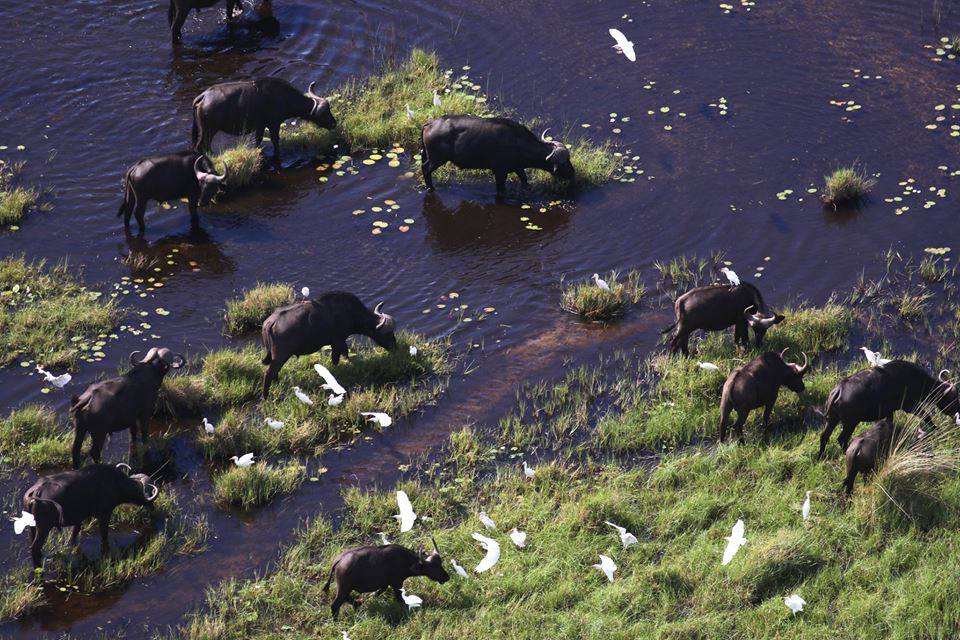
But please note: there is a difference between national parks and private concession in terms of accessibility and tourist frequencies!
Environmentalism & high costs: In order to run a camp in Botswana, the camp operator has to pay the government quite high conservation fees and leases for the areas. Together with the governmental restrictions, it encourages sustainable constructions in wildlife areas. The idea is that every camp is built in a sustainable way so that it can be removed completely after the lease expires, without leaving any traces in the landscape. And I think every person who has swapped from standard electricity to solar power knows how cost intensive the installation of such renewable energy sources is.
Both points have a convenient effect on the tourist experience on safari:
– On game activity, tourists in Botswana (normally!) face fewer other tourists and have an exclusive wildlife sighting – meaning they only share it between fewer vehicles whereas in other destinations vehicles already queue to a certain extent in case of an exciting predator sighting.
– Landscape is mainly impacted by natural forces and not by humans, which often goes along with strong photo opportunities. Moreover, most camps and mobile operators are perfectly equipped with open vehicles to make a photographic safari a success (no window-/vehicle frames, better light effects). This also creates a distinction between Botswana and other destinations, where only closed vehicles are allowed. Besides the clear commitment to photographic safaris by the companies, nature also does its part by providing unique undisturbed sceneries for its visitors and local people.
You don’t believe me? Check out the following hashtags on social media platforms like Instagram, Facebook or Twitter to get an idea of the beauty of Botswana:
#lostinbots & #whyilivehere & #thisischobe
There you have a proof of the diversity of landscapes Botswana has to offer: massive rivers (e.g. Chobe), dry savannahs (e.g. Savute), fascinating river systems (e.g. Okavango Delta), impressive salt pans (e.g. Makgadikgadi) and the vastness of the Kalahari desert.
– The diversity in landscape is not only an opportunity for landscape photography. It also provides different habitats and is therefore home to a wide range of animal species. Botswana boasts itself with “quality game”, not “quantity game”. Obviously we also count large herds of elephants and buffalos as well as comparably high numbers of predators (lions, leopards & cheetahs) in Botswana. But what other destinations can’t compete with is the high number of rare species like: wild dogs, brown hyenas, leopards, sable and roan antelopes to name a few. Normally these animals are hardly ever seen on conventional safaris. Botswana however provides the habitats for them and therefore increases the chances of witnessing these rare species on safari.
All those points lead to an exclusive safari experience, which is reflected in a higher price tag. But behind the tourist experience is a mostly unknown enormous logistic expenditure. And these need to be taken into consideration before labelling Botswana as “expensive”.
Food delivery and waste management: Botswana is a landlocked country, most supplies are imported from South Africa, by the time the food arrives in Maun it has travelled more than 1000 km already. From Maun the journey continues. Most camps are located in remote areas. In order to provide a culinary experience for guests during their stay, every single food item and can or bottle of beverage needs to be brought into camp. Due to most of them being inaccessible by road this is done by aircraft, which is not only a tremendously logistic operation but also results in high operational costs for the camps. And not only the fresh food is getting delivered, also the reverse transportation of waste out of wildlife areas takes place by aircraft.
High staff guest ratio: The staff members of the camps need to be flown in and out of camp (duty, leave, doctors visits,. ..) as well, and in order to deliver such a remarkable customer service the camps operate on high staff numbers. Normally 3 or more staff members are in camp for one guest. 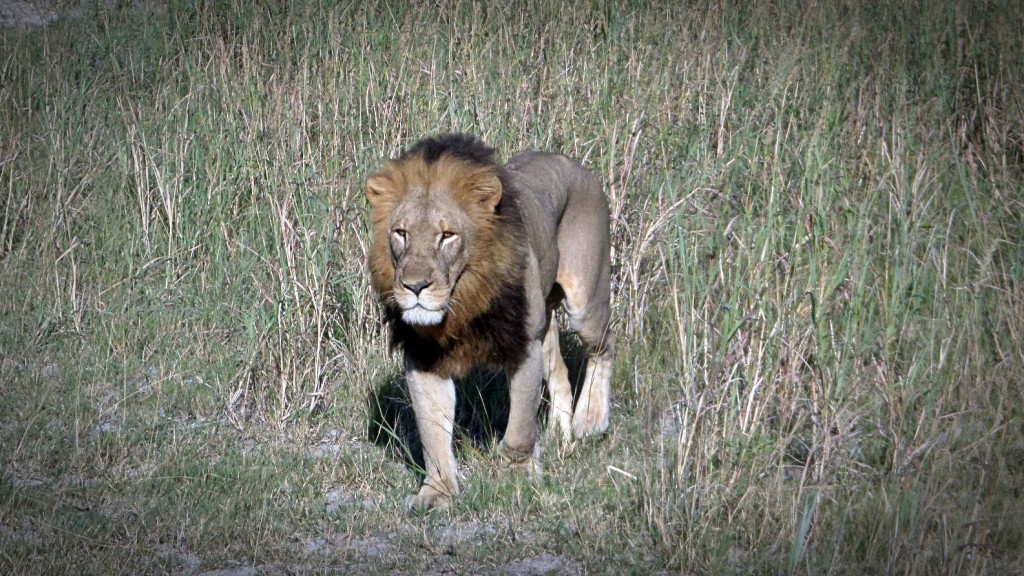
High maintenance costs: The location in the unspoilt wilderness also results in high maintenance costs for a camp. Water pipes break regularly because of animals impact, wood constructions or canvas need to be replaced several times – not only for the visual effect but also to be functional e.g. in keeping the heat out of a guests unit. The same applies to safari vehicles. They need to undergo frequent maintenance because of the “unhealthy” combination of water, heat and sand which quickly leads to signs of wear and tear. Additionally, spare parts need to find their way into camp which again involves logistical costs.
This shows that there are many visible and invisible components for the price tag.
Botswana – one of Africa’s best kept secrets!
The wheels of the bus go round and round…
The wheels of the bus go round and round. Round and round. Round and round. Do you remember that childhood song? It’s one of those little tunes that seem to get into your head and go round and round in a loop.
The reason for the song buzzing around every one’s heads in the 10FOR50 Team though, is because we are incredibly excited about our most significant donation ever!
A Community Bus!
That’s right; SD and TFI (though utilisation of SD derived bed night funding and our 10FOR50 contribution) have purchased a Community Bus.
A common thread out of our recently held presentations from NGO’s, and consultation with stakeholders, was the lack of reliable scheduled, free transport in Maun. Our bus is going to fill that void by solving the transportation challenges faced by Orphaned and Vulnerable Children (OVC’s) and the Elderly.
Jointly managed by SD and TFI the bus will perform scheduled morning runs delivering nutritious meals daily to Elderly Members of our community, as well as providing them with transport to collect pensions, medical necessities etc. In the afternoons the bus will collect OVC’s from their schools and transport them to Bana Ba Letsatsi and then back to their homes in the evenings.
We are so happy to be able to provide this service, which will provide mobility and independence to both the Future of our country by assisting our children as well as to the History of our country by assisting the Elderly.
This donation would not have been possible without the hard work, kindness and generosity of our Agents supporting the TFI Bed night Donation. A massive Thank You for your continued support!
Watch this space as we transform a bland 16 seater Mini-Bus into an awesome people moving, community supporting, Super Bus!
One last time…the wheels of the bus go round and round. Round and… (okay we’ll shut up now)!
